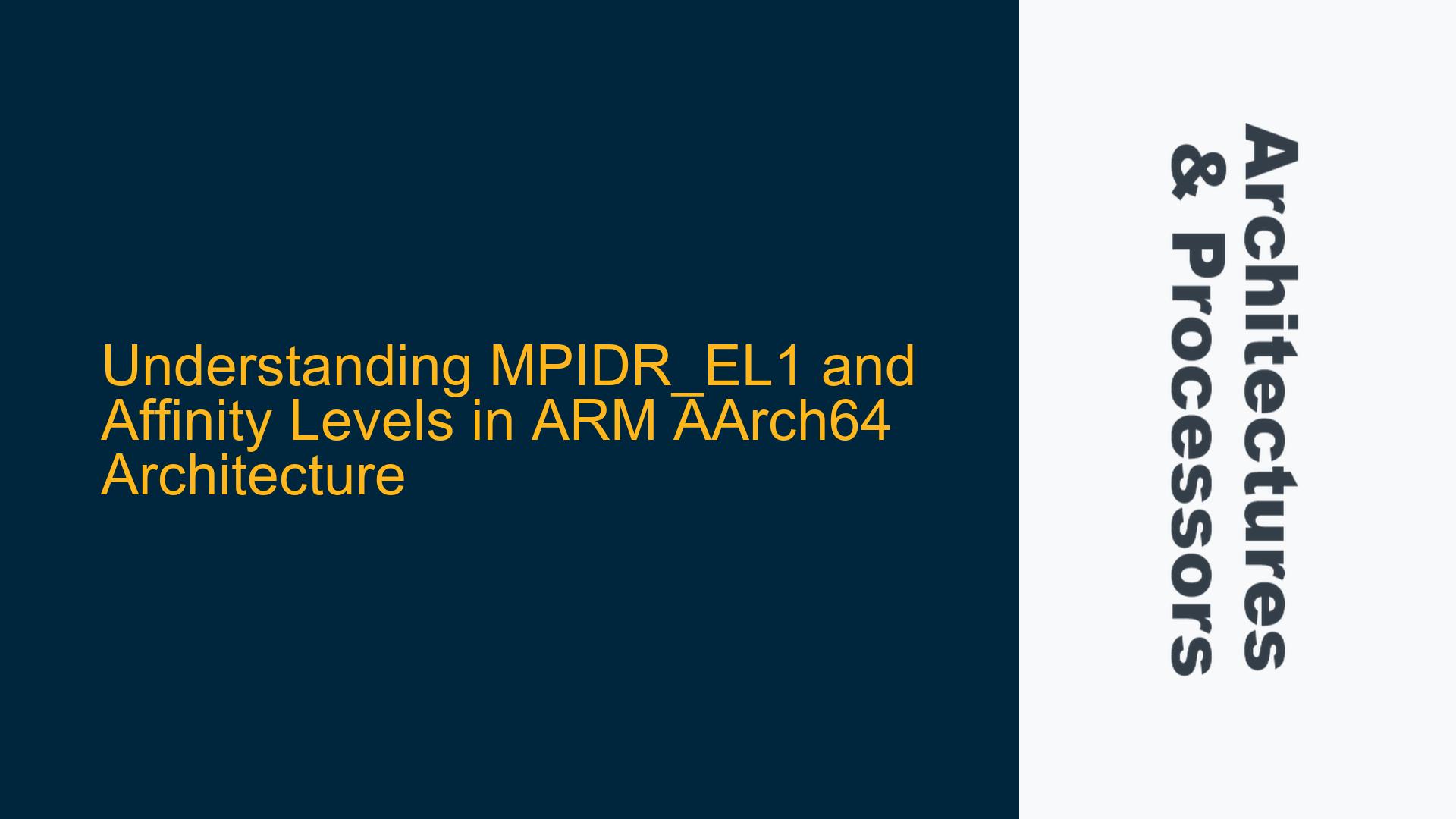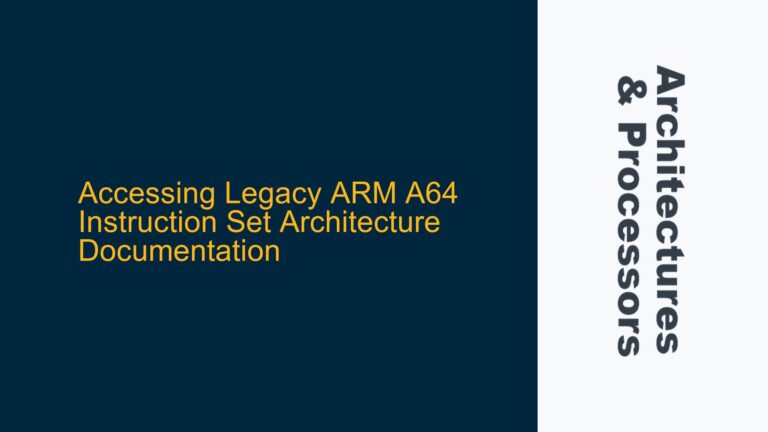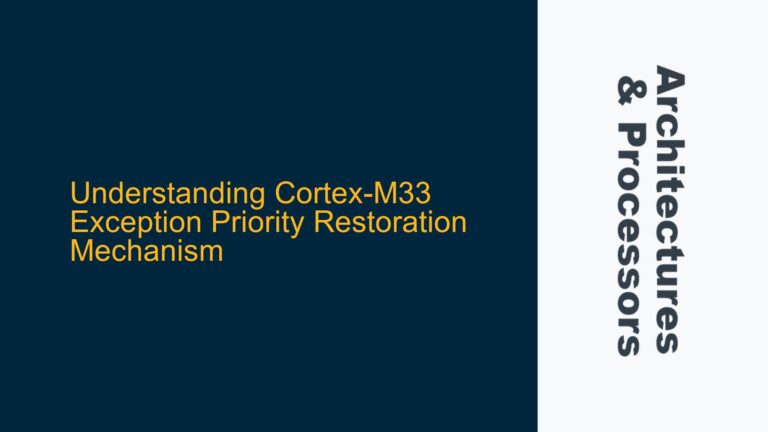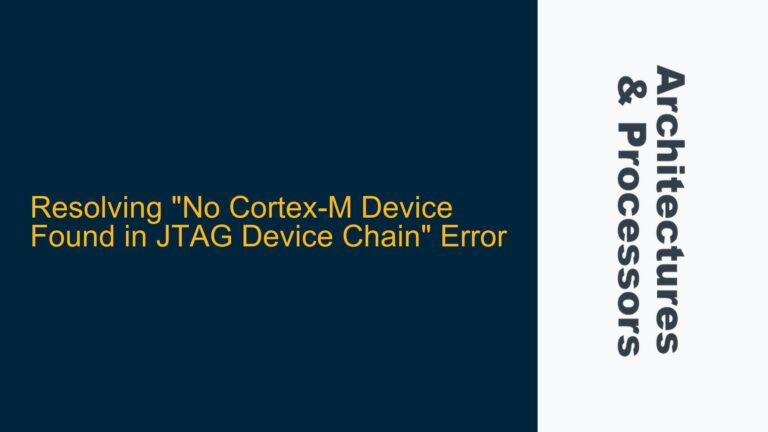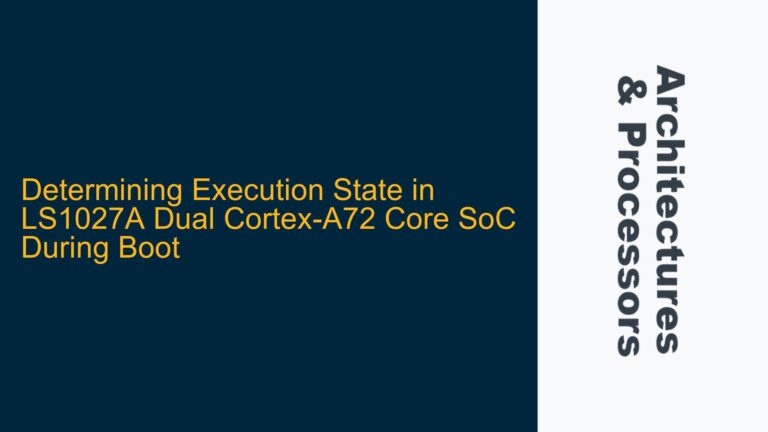MPIDR_EL1 Register and Affinity Levels in ARM AArch64
The MPIDR_EL1 (Multiprocessor Affinity Register) is a critical system register in ARM AArch64 architecture that provides information about the topology of the processor cores. This register is essential for operating systems and firmware to identify the core and cluster on which they are executing. The MPIDR_EL1 register is read-only and contains affinity levels (AFF0, AFF1, AFF2, and AFF3) that help in identifying the core, cluster, and other hierarchical levels in a multi-core system.
MPIDR_EL1 Register Structure and Affinity Levels
The MPIDR_EL1 register is structured to provide a hierarchical view of the processor cores and clusters. The register is 64 bits wide, but only certain bits are used to represent the affinity levels. The affinity levels are as follows:
- AFF0 (bits 0-7): Represents the core ID within a cluster.
- AFF1 (bits 8-15): Represents the cluster ID.
- AFF2 (bits 16-23): Represents additional hierarchical levels, such as superclusters or other groupings.
- AFF3 (bits 24-31): Represents higher-level groupings, such as sockets or nodes in a multi-socket system.
The MPIDR_EL1 register also includes other bits that provide additional information, such as the MT (Multithreading) bit, which indicates whether the core supports multithreading, and the U (Uniprocessor) bit, which indicates whether the system is a uniprocessor system.
How the OS Identifies the Core and Cluster
When an operating system boots on an ARM AArch64 system, it needs to identify the core and cluster on which it is running. This is done by reading the MPIDR_EL1 register using the MRS instruction. The OS can then use the affinity levels (AFF0, AFF1, AFF2, and AFF3) to determine the core and cluster IDs.
For example, if the OS reads the MPIDR_EL1 register and obtains the value 0x80000001, it can decode this value as follows:
- AFF0 = 0x01 (Core ID 1)
- AFF1 = 0x00 (Cluster ID 0)
- AFF2 = 0x00 (No additional hierarchy)
- AFF3 = 0x80 (Higher-level grouping, such as socket ID 0x80)
This information allows the OS to determine that it is running on Core 1 of Cluster 0 in a system with a higher-level grouping represented by AFF3.
Importance of AFF0 and AFF1 in Core and Cluster Identification
The AFF0 and AFF1 fields are particularly important because they directly identify the core and cluster, respectively. The AFF0 field (bits 0-7) specifies the core ID within a cluster, while the AFF1 field (bits 8-15) specifies the cluster ID. These fields are used by the OS to schedule tasks, manage interrupts, and perform other core-specific operations.
For example, in a system with four cores per cluster, the AFF0 field will have values ranging from 0x00 to 0x03, representing cores 0 to 3. The AFF1 field will have values representing different clusters, such as 0x00 for Cluster 0, 0x01 for Cluster 1, and so on.
Role of AFF2 and AFF3 in Hierarchical Systems
In more complex systems, such as those with multiple sockets or nodes, the AFF2 and AFF3 fields provide additional hierarchical information. The AFF2 field (bits 16-23) can represent superclusters or other groupings within a socket, while the AFF3 field (bits 24-31) can represent the socket or node ID.
For example, in a system with two sockets, each containing four clusters, the AFF3 field might be used to differentiate between the two sockets. A value of 0x00 in AFF3 could represent Socket 0, while a value of 0x01 could represent Socket 1. The AFF2 field could then be used to differentiate between clusters within each socket.
Practical Use of MPIDR_EL1 in OS and Firmware
The MPIDR_EL1 register is used extensively by operating systems and firmware to manage multi-core systems. During the boot process, the firmware reads the MPIDR_EL1 register to determine the core and cluster on which it is running. This information is then passed to the OS, which uses it to initialize the system and manage tasks across multiple cores.
In a multi-core system, the OS uses the MPIDR_EL1 register to identify the core and cluster for task scheduling, interrupt handling, and power management. For example, when an interrupt occurs, the OS can use the MPIDR_EL1 register to determine which core should handle the interrupt. Similarly, when managing power states, the OS can use the MPIDR_EL1 register to identify which cores are active and which can be put into a low-power state.
Common Misconceptions and Pitfalls
One common misconception is that the MPIDR_EL1 register can be written to or modified by software. However, the MPIDR_EL1 register is read-only, and any attempt to write to it will result in an exception. Another common pitfall is assuming that the AFF0 and AFF1 fields are always sufficient to identify a core in a system. In more complex systems with multiple hierarchical levels, the AFF2 and AFF3 fields must also be considered.
Another potential issue is the interpretation of the MT (Multithreading) bit. If the MT bit is set, it indicates that the core supports multithreading, and the OS must take this into account when scheduling tasks and managing resources. Failure to properly handle the MT bit can lead to performance issues or incorrect behavior in multi-threaded applications.
Conclusion
The MPIDR_EL1 register and its affinity levels (AFF0, AFF1, AFF2, and AFF3) are essential for understanding and managing multi-core systems in ARM AArch64 architecture. By reading the MPIDR_EL1 register, the OS and firmware can identify the core, cluster, and other hierarchical levels, enabling efficient task scheduling, interrupt handling, and power management. Understanding the structure and usage of the MPIDR_EL1 register is crucial for anyone working with ARM AArch64 systems, particularly in multi-core and multi-socket environments.
Memory Barrier Omission and Cache Invalidation Timing
In ARM AArch64 systems, memory barriers and cache management are critical for ensuring correct and efficient operation, especially in multi-core environments. The MPIDR_EL1 register plays a role in this context, as it helps the OS and firmware identify the core and cluster, which in turn affects how memory barriers and cache operations are performed.
Memory Barriers in ARM AArch64
Memory barriers are used to enforce ordering constraints on memory operations. In a multi-core system, different cores may execute memory operations out of order, leading to potential inconsistencies. Memory barriers ensure that all memory operations before the barrier are completed before any operations after the barrier are executed.
ARM AArch64 provides several types of memory barriers, including:
- DMB (Data Memory Barrier): Ensures that all memory accesses before the barrier are completed before any memory accesses after the barrier.
- DSB (Data Synchronization Barrier): Ensures that all memory accesses and other operations (such as cache maintenance) before the barrier are completed before any operations after the barrier.
- ISB (Instruction Synchronization Barrier): Ensures that all instructions before the barrier are completed before any instructions after the barrier are fetched and executed.
Cache Invalidation and MPIDR_EL1
Cache invalidation is another critical operation in ARM AArch64 systems. Caches are used to store frequently accessed data, but they must be invalidated when the data is modified by another core or device. The MPIDR_EL1 register helps identify the core and cluster, which is important for cache invalidation operations.
For example, when a core modifies a shared data structure, it must invalidate the corresponding cache lines in other cores to ensure that they see the updated data. The OS or firmware can use the MPIDR_EL1 register to identify which cores need to have their caches invalidated.
Timing Considerations for Cache Invalidation
Timing is crucial when performing cache invalidation. If cache invalidation is performed too early, other cores may still access stale data. If it is performed too late, other cores may have already accessed the stale data, leading to inconsistencies.
In ARM AArch64, cache invalidation is typically performed using the DC IVAC (Data Cache Invalidate by Virtual Address to PoC) instruction. This instruction invalidates the cache line corresponding to a specific virtual address. The OS or firmware must ensure that the cache invalidation is performed at the correct time, typically after the data has been modified and before other cores access the data.
Common Issues with Memory Barriers and Cache Invalidation
One common issue is the omission of memory barriers, which can lead to memory ordering violations and inconsistent data. For example, if a core modifies a shared data structure without issuing a memory barrier, other cores may see the modifications out of order, leading to incorrect behavior.
Another common issue is incorrect timing of cache invalidation. If cache invalidation is performed too early or too late, it can lead to data inconsistencies. For example, if a core modifies a shared data structure and then immediately invalidates the cache, another core may still access the stale data before the cache invalidation takes effect.
Best Practices for Memory Barriers and Cache Invalidation
To avoid these issues, it is important to follow best practices for memory barriers and cache invalidation:
- Use Memory Barriers Appropriately: Always use memory barriers when modifying shared data structures to ensure that the modifications are visible to other cores in the correct order.
- Perform Cache Invalidation at the Right Time: Ensure that cache invalidation is performed after the data has been modified and before other cores access the data.
- Use MPIDR_EL1 for Core Identification: Use the MPIDR_EL1 register to identify the core and cluster, which is important for cache invalidation and other core-specific operations.
Conclusion
Memory barriers and cache invalidation are critical for ensuring correct and efficient operation in ARM AArch64 systems. The MPIDR_EL1 register plays a key role in identifying the core and cluster, which affects how memory barriers and cache operations are performed. By following best practices and understanding the timing considerations, developers can avoid common issues and ensure that their systems operate correctly and efficiently.
Implementing Data Synchronization Barriers and Cache Management
In ARM AArch64 systems, data synchronization barriers (DSBs) and cache management are essential for maintaining data consistency and ensuring correct operation, especially in multi-core environments. The MPIDR_EL1 register is instrumental in these operations, as it helps identify the core and cluster, which in turn affects how DSBs and cache management are implemented.
Data Synchronization Barriers (DSBs) in ARM AArch64
Data Synchronization Barriers (DSBs) are used to ensure that all memory accesses and other operations (such as cache maintenance) before the barrier are completed before any operations after the barrier are executed. DSBs are particularly important in multi-core systems, where different cores may execute memory operations out of order, leading to potential inconsistencies.
In ARM AArch64, the DSB instruction is used to implement data synchronization barriers. The DSB instruction ensures that all memory accesses and other operations before the barrier are completed before any operations after the barrier are executed. This is crucial for maintaining data consistency in multi-core systems.
Cache Management in ARM AArch64
Cache management is another critical aspect of ARM AArch64 systems. Caches are used to store frequently accessed data, but they must be managed carefully to ensure data consistency. Cache management operations include cache invalidation, cache cleaning, and cache maintenance.
Cache invalidation is used to remove stale data from the cache, ensuring that the core accesses the most up-to-date data from memory. Cache cleaning is used to write back dirty data from the cache to memory, ensuring that the data in memory is up-to-date. Cache maintenance operations include cache line locking, cache line prefetching, and cache line zeroing.
Role of MPIDR_EL1 in Cache Management
The MPIDR_EL1 register plays a key role in cache management, as it helps identify the core and cluster. This information is important for cache management operations, as different cores may have different cache states. For example, when a core modifies a shared data structure, it must invalidate the corresponding cache lines in other cores to ensure that they see the updated data.
The OS or firmware can use the MPIDR_EL1 register to identify which cores need to have their caches invalidated or cleaned. For example, if a core modifies a shared data structure, it can use the MPIDR_EL1 register to identify the other cores in the same cluster and invalidate their caches.
Implementing DSBs and Cache Management
Implementing DSBs and cache management in ARM AArch64 systems requires careful consideration of the core and cluster topology. The MPIDR_EL1 register is used to identify the core and cluster, which affects how DSBs and cache management operations are implemented.
For example, when a core modifies a shared data structure, it must issue a DSB to ensure that the modifications are visible to other cores. It must then invalidate the corresponding cache lines in other cores to ensure that they see the updated data. The OS or firmware can use the MPIDR_EL1 register to identify the other cores in the same cluster and invalidate their caches.
Common Issues with DSBs and Cache Management
One common issue is the omission of DSBs, which can lead to memory ordering violations and inconsistent data. For example, if a core modifies a shared data structure without issuing a DSB, other cores may see the modifications out of order, leading to incorrect behavior.
Another common issue is incorrect cache management. If cache invalidation or cleaning is not performed correctly, it can lead to data inconsistencies. For example, if a core modifies a shared data structure and does not invalidate the corresponding cache lines in other cores, those cores may continue to access stale data.
Best Practices for DSBs and Cache Management
To avoid these issues, it is important to follow best practices for DSBs and cache management:
- Use DSBs Appropriately: Always use DSBs when modifying shared data structures to ensure that the modifications are visible to other cores in the correct order.
- Perform Cache Management Correctly: Ensure that cache invalidation and cleaning are performed correctly to maintain data consistency.
- Use MPIDR_EL1 for Core Identification: Use the MPIDR_EL1 register to identify the core and cluster, which is important for cache management and other core-specific operations.
Conclusion
Data synchronization barriers (DSBs) and cache management are essential for maintaining data consistency and ensuring correct operation in ARM AArch64 systems. The MPIDR_EL1 register plays a key role in identifying the core and cluster, which affects how DSBs and cache management operations are implemented. By following best practices and understanding the role of the MPIDR_EL1 register, developers can avoid common issues and ensure that their systems operate correctly and efficiently.
